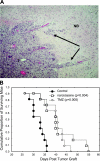Targeting of eEF1A with Amaryllidaceae isocarbostyrils as a strategy to combat melanomas
- PMID: 20643906
- PMCID: PMC3229423
- DOI: 10.1096/fj.10-162263
Targeting of eEF1A with Amaryllidaceae isocarbostyrils as a strategy to combat melanomas
Erratum in
-
ERRATUM.FASEB J. 2015 Sep;29(9):4080. doi: 10.1096/fj.10-162263ERR. FASEB J. 2015. PMID: 26330559 Free PMC article. No abstract available.
Abstract
Melanomas display poor response rates to adjuvant therapies because of their intrinsic resistance to proapoptotic stimuli. This study indicates that such resistance can be overcome, at least partly, through the targeting of eEF1A elongation factor with narciclasine, an Amaryllidaceae isocarbostyril controlling plant growth. Narciclasine displays IC(50) growth inhibitory values between 30-100 nM in melanoma cell lines, irrespective of their levels of resistance to proapoptotic stimuli. Normal noncancerous cell lines are much less affected. At nontoxic doses, narciclasine also significantly improves (P=0.004) the survival of mice bearing metastatic apoptosis-resistant melanoma xenografts in their brain. The eEF1A targeting with narciclasine (50 nM) leads to 1) marked actin cytoskeleton disorganization, resulting in cytokinesis impairment, and 2) protein synthesis impairment (elongation and initiation steps), whereas apoptosis is induced at higher doses only (≥200 nM). In addition to molecular docking validation and identification of potential binding sites, we biochemically confirmed that narciclasine directly binds to human recombinant and yeast-purified eEF1A in a nanomolar range, but not to actin or elongation factor 2, and that 5 nM narciclasine is sufficient to impair eEF1A-related actin bundling activity. eEF1A is thus a potential target to combat melanomas regardless of their apoptosis-sensitivity, and this finding reconciles the pleiotropic cytostatic of narciclasine. -
Figures






Similar articles
-
Narciclasine as well as other Amaryllidaceae isocarbostyrils are promising GTP-ase targeting agents against brain cancers.Med Res Rev. 2013 Mar;33(2):439-55. doi: 10.1002/med.21253. Epub 2012 Mar 14. Med Res Rev. 2013. PMID: 22419031 Review.
-
Structure-activity relationship analysis of novel derivatives of narciclasine (an Amaryllidaceae isocarbostyril derivative) as potential anticancer agents.J Med Chem. 2009 Feb 26;52(4):1100-14. doi: 10.1021/jm8013585. J Med Chem. 2009. PMID: 19199649
-
Narciclasine, an isocarbostyril alkaloid, has preferential activity against primary effusion lymphoma.Sci Rep. 2020 Mar 31;10(1):5712. doi: 10.1038/s41598-020-62690-9. Sci Rep. 2020. PMID: 32235878 Free PMC article.
-
Narciclasine - an Amaryllidaceae Alkaloid with Potent Antitumor and Anti-Inflammatory Properties.Planta Med. 2016 Nov;82(16):1389-1394. doi: 10.1055/s-0042-115034. Epub 2016 Aug 19. Planta Med. 2016. PMID: 27542176 Review.
-
Narciclasine, a plant growth modulator, activates Rho and stress fibers in glioblastoma cells.Mol Cancer Ther. 2009 Jul;8(7):1739-50. doi: 10.1158/1535-7163.MCT-08-0932. Epub 2009 Jun 16. Mol Cancer Ther. 2009. PMID: 19531573
Cited by
-
Alleviation of paclitaxel-induced mechanical hypersensitivity and hyperalgesic priming with AMPK activators in male and female mice.Neurobiol Pain. 2019 Sep 27;6:100037. doi: 10.1016/j.ynpai.2019.100037. eCollection 2019 Aug-Dec. Neurobiol Pain. 2019. PMID: 31650090 Free PMC article.
-
Structures and Biological Activities of Alkaloids Produced by Mushrooms, a Fungal Subgroup.Biomolecules. 2022 Jul 24;12(8):1025. doi: 10.3390/biom12081025. Biomolecules. 2022. PMID: 35892335 Free PMC article. Review.
-
Fungal metabolite ophiobolin A as a promising anti-glioma agent: In vivo evaluation, structure-activity relationship and unique pyrrolylation of primary amines.Bioorg Med Chem Lett. 2015 Oct 15;25(20):4544-8. doi: 10.1016/j.bmcl.2015.08.066. Epub 2015 Aug 24. Bioorg Med Chem Lett. 2015. PMID: 26341136 Free PMC article.
-
Towards a molecular understanding of the biosynthesis of amaryllidaceae alkaloids in support of their expanding medical use.Int J Mol Sci. 2013 May 31;14(6):11713-41. doi: 10.3390/ijms140611713. Int J Mol Sci. 2013. PMID: 23727937 Free PMC article. Review.
-
Cyclic versus hemi-bastadins. pleiotropic anti-cancer effects: from apoptosis to anti-angiogenic and anti-migratory effects.Molecules. 2013 Mar 19;18(3):3543-61. doi: 10.3390/molecules18033543. Molecules. 2013. PMID: 23519198 Free PMC article.
References
-
- Hamm C., Verma S., Petrella T., Bak K., Charette M. (2008) Melanoma Disease Site Group of Cancer Care Ontario's Program in evidence-based care. Biochemotherapy for the treatment of metastatic malignant melanoma: a systematic review. Cancer Treat. Rev. 34, 145– 146 - PubMed
-
- Atallah E., Flaherty L. (2005) Treatment of metastatic malignant melanoma. Curr. Treat. Options Oncol. 6, 185– 193 - PubMed
-
- Soengas M. S., Lowe S. W. (2003) Apoptosis and melanoma chemoresistance. Oncogene 22, 3138– 3151 - PubMed
-
- Eberle J., Kurbanov B. M., Hossini A. M., Trefzer U., Fecker L. F. (2007) Overcoming apoptosis deficiency of melanoma-hope for new therapeutic approaches. Drug Resist. Updat. 10, 218– 234 - PubMed
-
- Ivanov V. N., Bhoumik A., Ronai Z. (2003) Death receptors and melanoma resistance to apoptosis. Oncogene 22, 3152– 3161 - PubMed
Publication types
MeSH terms
Substances
Grants and funding
LinkOut - more resources
Full Text Sources
Other Literature Sources
Medical
Miscellaneous

